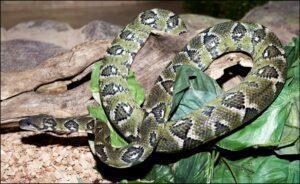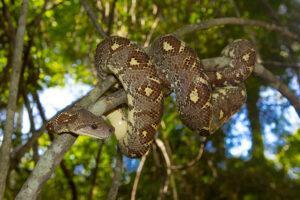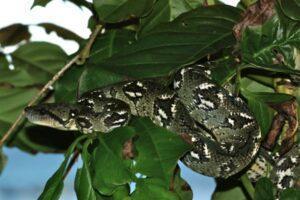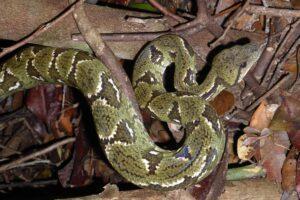The Madagascar tree boa, or Malagasy tree boa, as the name suggests, is endemic to Madagascar. The constrictor is usually nocturnal and arboreal. It has heat-sensing pits that help it forage warm-blooded prey in the dark. Despite its medium size, it is a mighty snake with strong jaws.
Scientific Classifications
- Suborder:Serpentes
- Family:Boidae
- Genus:Sanzinia
- Species:S. madagascariensis
Conservation Status
Description
Size
Adults of this boa species reach 4-5 ft (1.22-1.52 m) on average, though it is quite common to find individuals measuring 6-7 ft (1.83-2.13 m). The females are larger than the males.
Color and Appearance
The greenish background color of the boa is overlayed with darker markings, often with lighter centers. A dark stripe extends diagonally from its eye towards the back of its head. Its smooth glossy scales are neither ridged nor keeled, and its pupils are elliptical.
Are They Dangerous to Humans
The Madagascar tree boa is not aggressive. The shy snake tries to stay out of people’s way when hunting for food. If cornered, it can bite but can’t cause any harm as it is non-venomous.
As pets, they are docile and fairly easy to handle.
Madagascar Tree Boas at a Glance
Distribution
It lives in the eastern part of Madagascar.
Habitat
It prefers shrubs and trees near rivers, streams, swamps, and ponds.
Lifespan
Malagasy tree boas live for up to 30 years.
Predators
They are eaten by the fossa, larger snakes, and birds of prey.
Diet
Its diet consists of birds and mammals that it forages using thermoreceptive pits located between its labial scales. The boa’s razor-sharp teeth help it hold on to the prey as it kills it by constriction. It leaves trees to hunt small mammals on the ground.
Reproduction
Ovoviviparous (gives birth to live young from eggs that hatch inside the body)
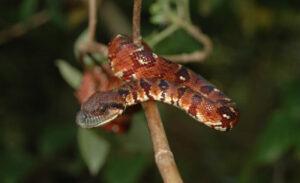
When females become gravid, their skins darken in color, increasing heat absorption for nurturing the young. After giving birth, their color returns to normal at their next molting. The juveniles are bright red, possibly to warn predators to stay away from them and help them camouflage among the bright flowers on tree tops.
Care Sheet
Size of the Enclosure: 3.2 ft (length) x 2.3 ft (width) x 2.3 ft (height) is the suitable enclosure size for housing an adult. It should have branches or shelves for climbing and a hiding box.
Temperature: The hot end temperature of the enclosure should be at 86°F-88°F, and at night it can drop to 70°F-72°F. The ambient temperature of the cage should be 75°F-77°F.
Humidity: The ideal humidity for the pet setup is 60-70%, and it should have a water bowl where the snake can soak completely.
Substrate: Soft wood substrates like Lignocel or Aspen, peat moss, and coco chips work well.
Feeding: Adults can be fed a well-sized rat every 3 weeks, while the babies can be given rat pinkies and mice every 7-10 days.
Source
dudleyzoo.org.uk, protectedareas.mg, wildherps.com, madamagazine.com, madamagazine.com

